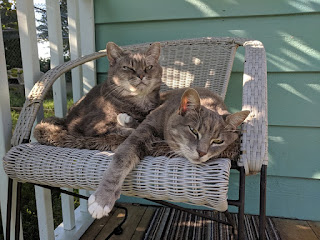This week's blog from volunteer Pauline Chin.
 |
| Tibet looks down from the cage-top - PC |
We have seen several cuddle kings over the years. These feline loverboys magnetically draw in many cats that snuggle right up to them. It was as if they possess magic – a love potion that extends beyond genders and makes other cats feel safe, relaxed, and full of purrs.
 |
| Tibet - MW |
So what makes them so attractive? Pheromones? A magnetic personality? Their aura? Mannerisms? Their plush fur? No one knows for sure. If only cats spoke human.…
 |
| Mario was a comfort to feral buddy Shrek - CF |
For veteran volunteers,
Mario was lovely in appearance and personality. He was the most well-known cuddler of cats. His presence was enough to entice a crowd of cats to form a snuggle pile on top of him. Only his fur was visible underneath the fuzzy bodies.
 |
| Salty (centre) and the boyz - Ridley (L) and Sid (R) - MW |
 |
| Dusty was one of Salty's many girlfriends - DW |
After Mario travelled to the rainbow bridge, it was Salty’s turn.
Salty spent most of his time on the couch of the double wide and the cuddlers followed suit. The couch was also the “secret spot” for visitors to have 5-10 cats walk all over them. (We know Salty did most of the work.) Sadly, Salty went to join Mario and we were left without a feline loverboy for a while.
 |
| Tibet - MW |
Unexpectedly, a noisy tabby emerged. After being caged for another treatment of a constantly recurring cold virus, back-pen cat,
Tibet, chose to stay in the Double-Wide. In recent months, he has shown the cage-top cats and back deck cats a great deal of physical affection. Tibet would walk up to almost any cat and give them a good head bonk, body rub, or spend naptime with them. Shadrack, Spike, Scooter, Lulu, even ferals Benji and Ringo have all received Tibet cuddles.
 |
| Judy & Tibet - MW |
During life in the back pens, he had a girlfriend named
Judy. Tibet moved on from that relationship, but Judy still searches for him. She briefly consoled herself cuddling in the newcomers area with
Sprocket – a young, handsome feral that used to spend a lot of time with big boy Tiger in an open cage in the Double-Wide. Tiger has now been adopted, and Sprocket is confident enough to venture out into the backyard.
 |
| Pixie's warning stare - MW |
In the double wide, Tibet’s new girlfriend was Pixie. Always out of reach, she was untouchable in the 15-ish years she spent with us. Through Tibet’s love and encouragement, she transformed into a happier cat, who finally welcomed petting in her final months.
 BC
BC
On the back deck, Tibet may have had a short romance with LouLou. Whatever it was, it was enough for her to become more confident, outgoing, and interested in people. Even Spike has changed. He makes it a point to hop down for petting during visiting hours. He even tries sharing a bed with Buddy, although the latter refuses cat cuddles.
Watch for the sneeze from above! - KN
Visitors initially become aware of Tibet by his snorting sounds/snoring/weird purr. They’re amused by it and it’s usually the conversation starter. Once spotted, he’s quick to approach (he used to be shy!). He leans down and offers his head for touching. Then shakes his head. Watch out for flying snot! For years, he was known for his incurable chronic congestion. One of the current causes for his snortiness is a polyp in his nasal passage, but there's no guarantee that its removal will quiet him down. Some animals and humans breathe loudly and that’s just how their bodies were built. Although it sounds like his nose is clogged, he can definitely smell when dinner is being served!
 MW
MW
If anything, Tibet’s physical affection for cats has grown leaps and bounds in just months. He is a charmer and a comforter. He loves cats and cats adore him – a true loverboy. We’re incredibly lucky to have Tibet. We get to enjoy his company and the positive changes he’s made in the cats.
Blog by Pauline Chin
Photos by Pauline Chin, Brigid Coult, Claire Fossey,
Karen Nicholson, Debbie Wolanski, Michele Wright




















































